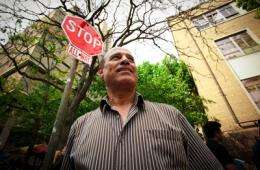Driver misjudgment and landscape variations cause collisions at stop sign intersections

(PhysOrg.com) -- Stop signs are supposed to be traffic safety tools, but how effective are they? According to one Ryerson University researcher, intersections with stop signs can be some of the deadliest places on the road.
In 2005 the Ministry of Transportation reported 62,000 crossing and turning collisions at stop-sign controlled and other types of intersections throughout Ontario, resulting in nearly 150 deaths and approximately 16,000 injuries. That’s nearly five times the number of fatalities as rear-end collisions in the same year.
Professor Said Easa of Ryerson’s Department of Civil Engineering says that speed and driver misjudgment are to blame. “When you want to cross a road or make an angular turn,” he explains, “you must judge the speed of the oncoming vehicle, estimate how fast it will reach the intersection, and compare that to your own ability to safely accelerate and manoeuvre. It’s very difficult to do, especially for older people. Their perception-reaction time is slower than younger drivers.”
Dr. Easa specializes in highway design and road safety. His most recent papers examine how minor (two-lane) roads and major (two- and four-lane) roads intersect. He writes that in addition to driver misjudgment, curves, hills and valleys on major roads can negatively affect the sight line of a driver on a minor road.
Using collision data from more than 5,000-kilometres of rural two-lane highways in Washington State, Dr. Easa and his research associate Qing Chong You created five statistical models to predict the frequency of vehicle collisions.
Among their findings, the researchers discovered that the biggest predictors of collisions along curved roads were the degree of the curve; the width, length and grade of the road; the average annual daily traffic; and the number of intersecting roads per kilometre. Those results, Dr. Easa hopes, will eventually prove useful in evaluating road safety improvements and optimizing the cost-effectiveness of highway design.
In his second study, Dr. Easa created another mathematical model. This one, however, aims to improve safety at existing and new intersections that are obstructed by large curves on a major roadway. In particular, Dr. Easa was concerned with sight distance - that is, the time gap between when a driver on a minor road sees a vehicle that rounds a curve and comes into view on the major road and when this vehicle arrives at the intersection. Clearly, this time must be greater than the time required by the minor road vehicle to cross the road, or turn left or right.
To aid driver judgment, Professor Easa’s and one of his former PhD students, Dr. Essam Dabbour, collaborated to develop an in-vehicle collision prediction system for consumers that takes the guess-work out of intersections. The on-board system, which is still under development, would calculate whether or not it’s safe to proceed forward.
More information:
Dr. Easa and Qing Chong You’s research study, entitled Collision Prediction Models for Three-Dimensional Two-Lane Highways: Horizontal Curves, was published in the journal Transportation Research Record in September 2009.
Dr. Easa’s second report, entitled Stop-Controlled Intersection Sight Distance: Minor Road on Tangent of Horizontal Curve, was published in the September issue of the Journal of Transportation Engineering.
Provided by Ryerson University

















